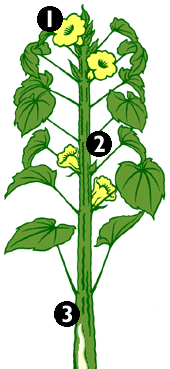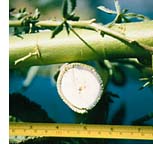Kenaf
cannot run wild
across the country
like a weed,
because in almost all parts of the
U.S., kenaf seeds
cannot mature.
All art © 1998
Vision Paper

![]() Kenaf is a 4,000 year old NEW crop with roots in ancient
Africa.
Kenaf is a 4,000 year old NEW crop with roots in ancient
Africa.
A member of the hibiscus family (Hibiscus cannabinus L), it is related to
cotton and okra, and grows well in many parts of the U.S. It offers a way
to make paper without cutting trees.
Kenaf grows quickly, rising to heights of 12-14 feet in as little as 4 to
5 months. U.S. Department of Agriculture studies show that kenaf yields
of 6 to 10 tons of dry fiber per acre per year are generally 3 to 5 times
greater than the yield for Southern pine trees,
which can take from 7 to 40 years to reach harvestable size. There are
many different varieties of kenaf, and certain varieties will perform better in
certain locations, or under certain conditions than other varieties.

![]() The different
varieties of kenaf have different flowering schedules. Some varieties
flower earlier than others. Generally, the flowering will last 3 to 4 weeks, or more, per plant,
and each individual flower blooms for only one day.
The different
varieties of kenaf have different flowering schedules. Some varieties
flower earlier than others. Generally, the flowering will last 3 to 4 weeks, or more, per plant,
and each individual flower blooms for only one day.
![]() The stalk of the
kenaf plant consists of two distinct fiber types. The outer fiber is called "bast" and comprises roughly 40%
of the stalk's dry weight. The refined bast fibers measure 2.6mm and are
similar to the best softwood fibers used to make paper.
The stalk of the
kenaf plant consists of two distinct fiber types. The outer fiber is called "bast" and comprises roughly 40%
of the stalk's dry weight. The refined bast fibers measure 2.6mm and are
similar to the best softwood fibers used to make paper.
![]() The whiter, inner fiber is called "core", and comprises 60%
of the stalk's dry weight. These refined fibers measure .6mm and are comparable
to hardwood tree fibers, which are used in a widening range of paper products.
The whiter, inner fiber is called "core", and comprises 60%
of the stalk's dry weight. These refined fibers measure .6mm and are comparable
to hardwood tree fibers, which are used in a widening range of paper products.

![]() At
the end of the growing season, the kenaf plant flowers. After blooming
the flower drops off, leaving a seed pod behind. In most parts of
the U.S. the seeds will not mature.
While there are certain varieties of kenaf that flower early, the
biomass production of those varieties is not substantial enough to provide
fiber economically. Because of their African origin they require an additional 60-90 days
of frost free conditions to reach the point of germination. This means
kenaf cannot run wild across the country like a weed.
It also presents some interesting challenges for developers to insure
a consistent supply of seed for next year's crop. Much research work is
being done in the area of seed development, with leading edge companies
like Vision Paper developing
innovative and environmentally sound solutions.
At
the end of the growing season, the kenaf plant flowers. After blooming
the flower drops off, leaving a seed pod behind. In most parts of
the U.S. the seeds will not mature.
While there are certain varieties of kenaf that flower early, the
biomass production of those varieties is not substantial enough to provide
fiber economically. Because of their African origin they require an additional 60-90 days
of frost free conditions to reach the point of germination. This means
kenaf cannot run wild across the country like a weed.
It also presents some interesting challenges for developers to insure
a consistent supply of seed for next year's crop. Much research work is
being done in the area of seed development, with leading edge companies
like Vision Paper developing
innovative and environmentally sound solutions.
Updated: October 26, 2010 03:44 PM





%20of%20ButOriginal.jpg)



